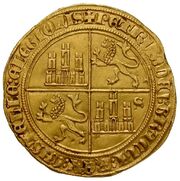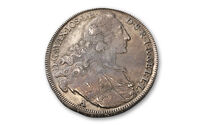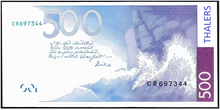| Thaler | |
|---|---|
| Basic information | |
| ISO 4217 code | BTH |
| Users | |
| Inflation rate | 1,7% (2002) |
| ERM | |
| Since | 19 June 1989 |
| Fixed rate since | 31 December 1998 |
| Replaced by €, non cash | 1 January 1999 |
| Replaced by €, cash | 1 January 2002 |
| Detail information | |
| Symbol | Th. |
| Sub unit | Cent |
| Coins | 1c, 2c, 5c, 10c, 20c, 50c, 1 Th., 2 Th. |
| Banknotes | 5 Th., 10 Th., 20 Th., 50 Th., 100 Th., 200 Th., 500 Th. |
| Issuing authority | Central Bank of Brunant |
The Thaler was the currency used by Brunant before its replacement with the Euro in 2002. The thaler was first introduced in 1537 and was in use for some 460 years. In 2002 the thaler gave way to the euro, at a fixed rate of 2.0917 Th. per euro and 0.478 euro/thaler.
Etymology[]
The thaler was named after the Joachimsthaler from Bohemia, first introduced in 1537. It is unknown why the currency was named after said coin. By the 19th century and into the 20th century the abbreviation <<tal.>> came into use, but by the 1970s was replaced by <<Th.>>, which became the official abbreviation and symbol for the currency in 1989.
History[]
First thaler[]

10 gold Thalers, 1571
The first thaler was introduced in 1537 at a rate of 200 old Crowns per Thaler (though few people still had the old crowns, as most were melted down in 1508 and 1509). This currency was issued in copper coins of 1/2, 1, 3 and 10 cent, in silver coins of 1/4, 1/2 1 and 2 Thalers and in gold coins of 5, 10 and 12.5 Thalers. This thaler varied in value, anywhere from 5 to about 20 ducats. During the Brunanter Civil War the minting of currency was reduced. Gold coins were not struck, silver pieces were made of base metals and copper coins were replaced by paper promissory notes. Public distrust in paper and "cheap currency" greatly reduced its value and this currency stopped being issued when Karl Van Draak took control.
Second thaler[]

50 Thalers, 1705
The second thaler was introduced in 1665 at a rate of 74 old for one new. It was redenominated at 32 cents/thaler. This was issued in coins of 1, 2, 4, 8 and 16 cent (copper); 1, 5, 10 and 12.5 thalers (silver). Due to its stability, it became a heavily traded currency in the Mediterranean for many years. In 1703 a shortage in silver forced the government to introduce paper notes of 10, 12.5 and 20 Thalers. A lack of gold coins and a shortage in silver led to distrust and a rise in inflation. By 1704 a silver thaler was worth 21 paper ones and in 1705 around 240-250. That year notes of 50, 100 and 150 thalers were issued which were soon rendered worthless (by January 1706 one needed 600 paper thalers to get a silver one). Coin mintage soon stopped and Spanish Reales became the common currency.
Guldenthaler[]

1761 Thaler (Pieter I)
The Guldenthaler (golden thaler) was the third Brunanter currency to be introduced, in 1707. This replaced the old paper thaler at a rate of 1000 to 1, and coins at a rate of 12 to 1. This was issued in the same denomination as the second thaler, plus it had gold coins of 20 and 30 thalers. As this currency was backed by gold, it was stable over a long period of time (5 thalers equaled 4 Reales and later 50 U.S. cents). In 1831 this was complemented by notes of 1/4 and 1/2 thaler, and soon local banks were also issuing notes in change (stranger denominations included 1/3, 7 1/2 and even 13 Th. The Central Bank introduced regular notes beginning 1868 in denominations of 5, 10, 20, 50, 100 and 500 th. The thaler was later valued at 2 per French franc (approximately 10 per British pound). Inflation at the beginning of the 20th century saw higher-denomination notes being issued. The guldenthaler remained in use until 1912, when currency decimalization was introduced.
Fourth thaler[]

The back of 500 thalers
See also: Banknotes of the Brunanter Thaler, Coins of the Brunanter Thaler
Decimalization occured in 1912 after a long period of study. By then 1, 2 and even 4 thalers were pretty worthless and consequently the Thaler was, too. It was there fore decided to make 2 old cents equal one new cent (6.25 old Th. equaled 1 new Thaler). This thalers was used until 2002 when the Euro was instead. At the time of retiring, one needed 1.84 Th. to equal one US dollar.
Introduction of the euro[]
On January 1 1999, the euro became the official currency of Brunant, though only electronically and for bookkeeping purposes. The thaler continued to serve as the actual hard currency, albeit as a de-facto sub-unit of the euro. On 1 January 2002 the euro was officially introduced in its had form (coins and banknotes) though the thaler continued to circulate until 31 December 2002. Thaler coins and currency are allowed to be exchanged indefinitely at the central bank, though only those that were in active use until the retirement of the thaler in 2002.
Exchange rates[]
| Year | BTH to USD | USD to BTH |
|---|---|---|
| 1913 | 4.7215 | 0.2117 |
| 1923 | 4.402 | 0.2271 |
| 1933 | 3.6218 | 0.2761 |
| 1940 | 3.550 | 0.2816 |
| 1948 | 3.9025 | 0.2562 |
| 1953 | 2.9862 | 0.3348 |
| 1958 | 2.7989 | 0.3572 |
| 1963 | 2.7127 | 0.3683 |
| 1968 | 2.5728 | 0.3886 |
| 1973 | 2.4014 | 0.4164 |
| 1978 | 2.3338 | 0.4284 |
| 1983 | 2.2231 | 0.4498 |
| 1988 | 2.0617 | 0.4850 |
| 1993 | 1.9786 | 0.5054 |
| 1999 | 1.8450 | 0.5419 |
Trivia[]
- Oliver Hewton has the largest collection of Thaler coins in the country, even having some from the 1500's.
- The 1814 Gold 5 Thalers is the rarest and most expensive coin of Burnant.
